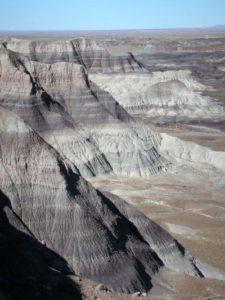 The Friends of Petrified Forest have begun talking with a freelance fundraiser as they consider ways to pursue fundraising on the park’s behalf. Here are a few of the ideas being presented to the fundraiser for consideration.
The Friends of Petrified Forest have begun talking with a freelance fundraiser as they consider ways to pursue fundraising on the park’s behalf. Here are a few of the ideas being presented to the fundraiser for consideration.
Support Science Interns
Every year, park scientists go into the field to learn more about the natural and cultural resources of Petrified Forest National Park. Summer science interns have traditionally played an important role in assisting these scientists while gaining valuable hands-on experience in their field of study.
However, internships have been available unevenly, depending upon the availability of funds. The park proposes to ensure through donation that at least 4 science internships are available every year. Support for interns includes a stipend of $1600 for a 10-week internship and $600 for tools, equipment, supplies, and rent in park housing (required by agency policy).
Student interns – $2200 each x 4
Small Project Support
Petrified Forest protects a wealth of natural and cultural resources in the fields of geology, paleontology, archeology and biology.
However, the NPS also has strong mandates for scientific research and visitor education. One of the main goals of the park resource program is to learn about the park story through our resources so that these stories can be disseminated to the public and other stakeholders.
The research potential at Petrified Forest is nearly limitless and in the past much of the figuring out of our story has been done by graduate students collecting data for their respective dissertations and theses.
In the last decade support for student projects has been non-existent. We are seeking donations of any amount to build an account from which annual research awards for students can be drawn. These will be available to graduate students from reputable institutions who will conduct graduate level research in the park. Awards will average $2000 per student and can be used to cover items such as travel, minor equipment, and lab expenses.
Adopt-a-Prairie Dog
Prairie dogs are an integral part of the high-desert grassland ecosystem. They are considered to be a keystone species because their colonies directly support dozens of other species, who either use the burrow systems for shelter or rely on dogs for food. In addition, the burrows aerate and fertilize soils and are critical for overall ecosystem health.
Once extremely common, prairie dog populations have dropped substantially in recent years because of habitat loss and sylvatic plague. Populations in Arizona have been so decimated that the Gunnison’s Prairie Dog is now considered a species of concern by the State of Arizona. Populations in Petrified Forest have also been negatively affected by plague.
Park management has made improved prairie dog colony health a top issue. We hope to treat existing colonies that make them more resistant to plague and to add to our populations by serving as a relocation site for colonies threatened by euthanization in urban areas. Our ultimate goal is to return our prairie dog populations to historic levels and eventually reintroduce the endangered Black-footed Ferret.
We are looking for donations of any size that can be used to treat burrows for fleas that cause plague, purchase vaccines for individual dogs that protect them from plague, and assist with the relocation of colonies from urban areas.
Non-invasive Wildlife Monitoring Tools
The Biology staff conducts wildlife surveys year-round including capturing small animals in live traps, visual observations in various habitat types, and driving the road at night looking for animals seeking residual heat from the pavement.
Survey methods are tailored to the target species groups, but often, the presence of the observer can affect the numbers of animals we see or alter their natural behavior (they run and hide).
One method we’ve used to capture species occurrence, distribution, and behavior is unattended trail cameras. We currently have three cameras that are employed constantly. These cameras can be set up anywhere in the park and take photos or videos of animals day and night. Just a few of the questions we can answer with trail cameras:
- Timing and species composition of animals using natural and artificial water sources
- Species composition and behavior at bird roost sites and nests
- Species composition and numbers of animals using major game trails
- Sequence and progression of scavengers on an animal carcass
- Movement patterns through constricting landscape features
- Nuisance animal behavior to inform remediation actions
A camera setup including rechargeable batteries, memory card and a metal security box with cable and padlock costs $300. We are looking for an additional 10 cameras to answer the questions above and many others.
Anyone interested in these or other opportunities to support the park is welcome to contact the Friends of Petrified Forest National Park.